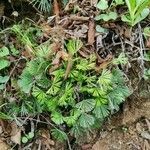Plants terrestrial or epilithic. Rhizome short-decumbent, closely branched, to 2 mm in diameter, closely set with roots, persistent stipe bases and bicolorous scales, scales with a crustaceous, black to castaneous central stripe, nitid, and ferrugineous to stramineous, chartaceous to membranous margins, sessile, linear to narrowly lanceolate, base somewhat round-auricled, cordate, entire to repand, apex terminates in an oblong thin-walled cell, to 4 mm long, to 1 mm wide. Fronds crowded, erect, caespitose, homomorphic, to 160 mm long; stipe firm, proximally brown, green higher up, narrowly winged along entire length, shallowly sulcate adaxially, to 130 mm long, to 1.2 mm in diameter, sparsely scaled, scales thin-chartaceous, concolorous, stramineous, sessile, linear-hastate, entire or irregularly set with short marginal outgrowths, apex terminates in an oblong thin-walled cell, to 3 mm long, to 0.5 mm wide; lamina anadromous, firmly herbaceous, flabellate, edges forming an angle of 150-180°, divided into 2 symmetrical halves by a deep median notch, each to 4 times dichotomously branched, to 32 mm long, muricate adaxially, abaxially initially sparsely set with scales similar to, but smaller than, those on the stipe, lamina declinate when desiccated; segments up to 48 per lamina, linear, of variable length, to 1.2 mm wide, each ending in 3 or 4 acute teeth. Venation adaxially obscure, raised abaxially, dichotomously forked, ending in the teeth. Sori linear, along outer segment veins; receptacle nude; sporangium stalk simple, 3-seriate below capsule, capsule broadly elliptic in lateral view, with (17-)19(-20) indurated annulus cells, epistomium (5-)6(-7)-celled, hypostomium (5-)6-celled; indusium membranous, continuous along segment margin, entire. Spores trilete, tetrahedral-globose, with an equatorial flange, proximal face verrucuose, distal face hemispherical, rugate, (46-)56.2(-60) µm in diameter.
More
Rhizome c. 4 mm in diameter, set with rhizome-scales c. 3 mm long with a central black stripe and pale brown borders, or concolorous. Fronds densely tufted, erect, coriaceous, uniform; stipe glaucous to stramineous, mostly glabrous, becoming castaneous and bearing a few linear-lanceolate scales basally, up to 135 mm long; lamina flabellate with a truncate base, repeatedly dichotomously divided into up to 48 narrow linear segments, entire except for a sharply dentate apex with 2-6 teeth, margins usually reflexed, upper surface with minute, short hairs, under surface set with brown, linear-lanceolate, hair-pointed scales, especially basally; fertile fronds often a little longer than sterile fronds with lamina sharply declinate when desiccated.
Rhizome creeping, set with rhizome scales. Fronds uniform or very weakly dimorphic, densely tufted. Stipe up to 135 mm long. Lamina flabellate with a truncate base, dichotomously divided into narrow linear segments, apex sharply dentate with 2-6 teeth.

